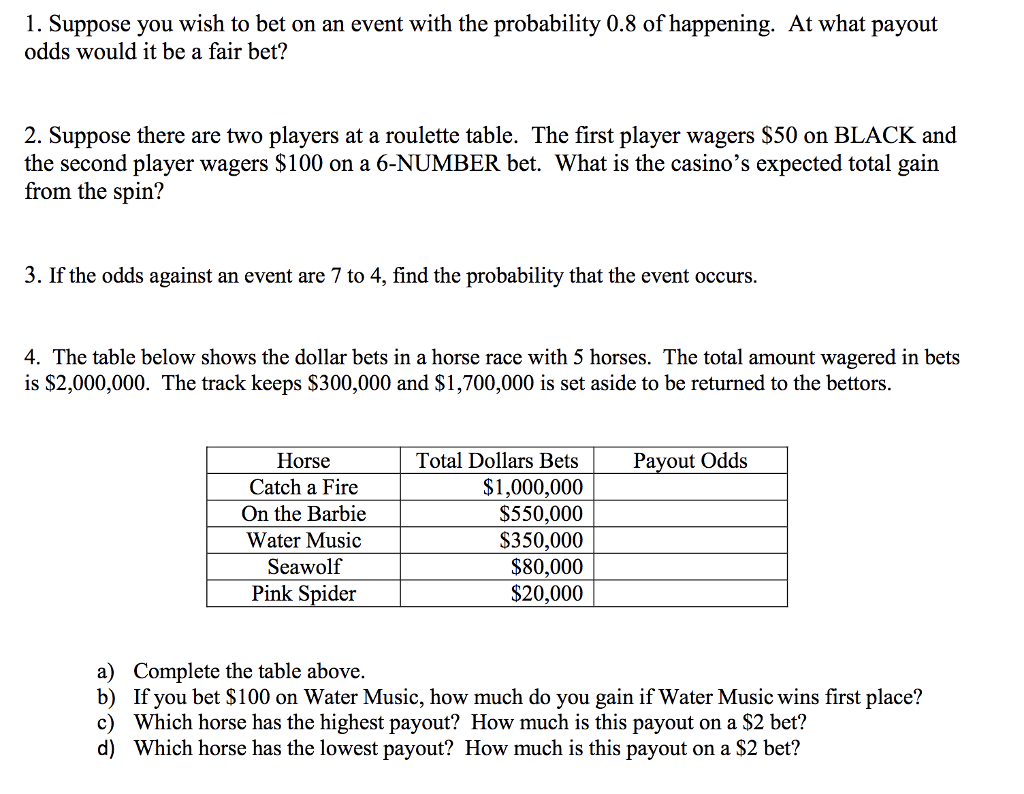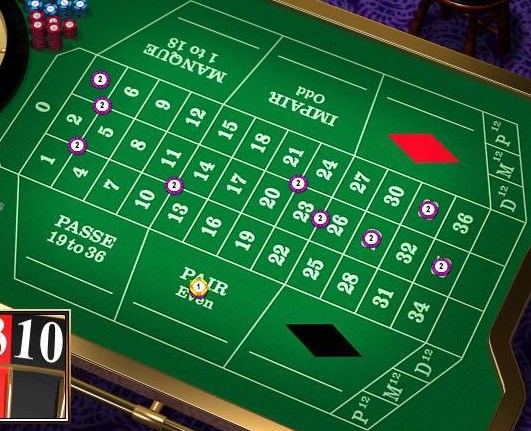Odds Payout
Many people start their betting journey with the same question. How do odds work? The answer to this question is incredibly important if you want to become a successful bettor, but it’s also only the start of a long journey. Read on to find out why all bettors need to know how odds work.
Using the +120 odds, it shows us that a $100 bet on that outcome would pay out $120 in profits. Again this can easily be converted into smaller or larger size bets. A $10 bet on +120 odds would pay out $12 in profits. Examples: Below is an example of NFL betting odds taken from an online betting site. Go to the Powerball Numbers page to see the latest prize payouts. The Powerball payout chart below shows how many numbers you need to match to win the different prizes and the odds of winning each. You can also see statistics about past winners in each division. Calculating Payouts From Moneyline Odds. In the United States, most bookmakers use the moneyline format to express the odds they offer for wagers. Thus, moneyline odds are also commonly referred to as American odds. They can be either a positive number or a negative number.
There is a conversation that all seasoned bettors will have had numerous times with friends and relatives who want a casual bet on a major sporting event. What are the odds on x? What do they mean? What will I win if I bet x amount?
The answer you give to these types of questions will vary depending on how much detail you want to go into, but they will centre around the same concept. Probability.
What do odds represent?
Bookmakers present their odds in decimals, fractions or an American format. They all look different but they all mean the same thing. All odds are a representation of the probability of something happening.
The fact that there are many different odds formats - American, Decimal and Fractional - illustrates the point that odds are simply a means to an end, i.e. offering betting. Bookmakers really deal in risk measured by probability.
Betting is about assessing the chance or probability of an event happening and bookmakers like Pinnacle use odds because it translates implied probability into a more usable form in order to offer betting.
Using implied probability in betting can also help you compare odds between bookmakers. However, if you consider betting to be just about odds, you're missing the bigger picture. To really expand your understanding of odds and betting, you must also understand how to calculate probability.
With a good understanding of how to calculate probability yourself and how it compares to the odds provided by the bookmaker, you can begin to make more informed decisions when it comes to what you should bet on, when you should bet and how much you should stake for the bets you make.
Basics of Betting How does betting work? - Episode 1
The basics of probability
Considering how we are faced with a problem to solve or an assessment of risk every single day of our lives, it is surprising how unfamiliar the average person is with being able to calculate probability.
How often do you think: “What are the chances of me making that train on time?” or “How likely is it to rain?”
We rarely attribute a numerical figure to answer these questions but we are still dealing with a question of probability.
Using implied probability to calculate a bookmaker’s margin is easy and very useful as few, if any, bookmakers publicly share it.
In the simplest of terms, probability is a scale running from 0 (where there is no chance of an event occurring) to 1 (a certain future event). The likelihood of all other potential outcomes fall somewhere in between those two end points of the probability spectrum.
A coin toss is a great way to explain how to calculate probability because we know the true probability for each outcome. The coin will definitely land on either heads or tails, which taken together provide us with the certain event. We now know this certain event has a probability of 1.

Of course as a bettor what you really want to know is the probability (or chance) of your chosen call, which we will say is heads. To do this there is a simple equation:
Favourable outcomes / all possible outcomes
If you are calling heads, then the favourable outcome will be heads. Therefore to get your probability value, you divide the favourable outcome (in this case there is one, heads) by the number of possible outcomes (this is two as it will either be heads or tails). This leaves us with a probability of 0.5.
In general people are more comfortable with percentages, so by multiplying the probability of your event (0.5 for heads) by 100 you can say that there is a 50% chance of the coin landing on heads, and you winning your bet.
How to calculate betting odds

Getting a handle on how to calculate probability yourself and converting it into odds is the first step in developing your own assessments of betting value.
Once you know how to calculate probability, turning that figure into odds is a straightforward process. Decimal odds are one of the three main formats used by bettors and bookmakers alike.

You can arrive at the Decimal odds value for your coin toss choice with the simple equation:
So the Decimal odds for a coin being heads is 1 (certainty) divided by the probability of it occurring which we know is 0.5, producing decimal odds of 2.0. At this point you can equally take odds and reverse engineer the implied probability with the inverse of the equation for turning probability into odds:
1/decimal odds = probability

Take your newly found knowledge and work out the implied probability for your coin toss with your friend and you'll see the aggregate implied probability of both outcomes in the coin toss is 100% - (0.5/1+0.5/1)*100 - no surprises as a certain event is 1 (100/100).
Odds Payout
However, performing the same calculation for actual odds from your favourite bookmaker will produce a value greater than 100%. So what is happening here?
Odds Payout Formula
Calculating a bookmaker’s margin
In simple terms the odds don't reflect the true likelihood of the outcomes concerned with an event. The amount by which the implied probability diverges from 100% is the margin the bookmaker has added to that particular that market.
This is an essential piece of information for a value-seeking bettor as it highlights the true cost of placing a bet with a bookmaker. Using implied probability to calculate a bookmaker’s margin is easy and very useful as few, if any, bookmakers publicly share it.
While it is important you are able to use the above information to convert odds into probability and calculate a bookmaker’s margin, you don’t have to do it yourself for every single bet. If you want a quick way to calculate how much margin a bookmaker has applied to the odds, you can use Pinnacle’s Margin Calculator.
Using odds to calculate your payout
Calculating odds and probability opens up a new world for calculating value but you also want to know what your bet will payout if you win. For our coin toss example this requires a simple multiplication:
So if you bet €10 on heads with odds of 2.0 your return including stake is 2.0 x €10 which equals €20 (this includes your €10 stake + €10 profit).
- Read: Do you know how difficult betting is?
Being able to calculate probability and understand where odds actually come from is an essential part of evolving as a bettor because it enables you to calculate your own expected frequency for an event - starting to model your own odds - and then compare what you think will happen with what odds are available.
Where the two diverge you can potentially turn that edge in your favour, and generate profit, which is what a bettor should be focused on.
If you want to calculate the return and profit of your bet, Pinnacle's Bet Calculator will do the work for you.
Now that you know how to calculate betting odds, you can take advantage of Pinnacle's low margin odds or read more expert betting articles to help make more informed betting decisions.
A parlay is a single bet that links together two or more individual wagers for a high payout. A 2 team parlay might pay 13/5, a three team parlay might pay 6/1, a four team parlay might pay 10/1, and so forth with the payouts getting higher with more teams or totals selected. For a single bet, 2 to 8 teams or totals can be selected.

In order for the parlay bet to win, every one of the wagers must win or push (tie). If any of the selections lose, your wager loses, regardless of the outcome or cancellation of the other games. If one or more selections is a tie, postponed, incomplete, cancelled or rescheduled for another day, then the wager reverts to the next lowest number. For example, if you place a 5 team parlay and have 4 winners and a tie, your wager pays out as a 4 team parlay. If you place a 2 team parlay and one team wins and one ties, the wager becomes a straight bet.
The resulting wager will have the same risk amount with the win being calculated to reflect the odds of the remaining team (Example: On a two team $100 parlay with team A +110 and team B -110 if A ties and B wins the resulting wager will be a straight play on B risking $100 to win $91).